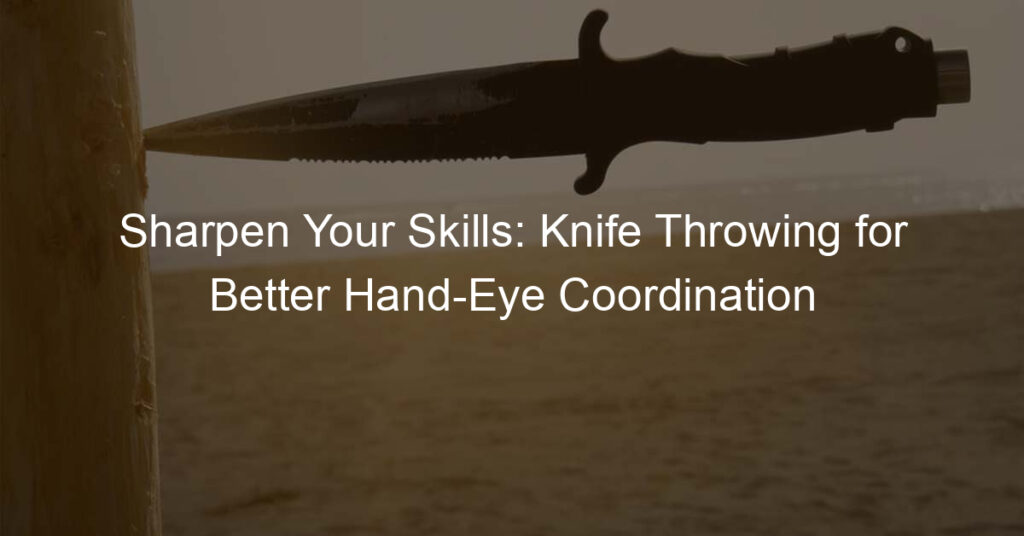Knife throwing is a skill that has been around for centuries. It’s a great way to show off your knife-handling skills and impress your friends. But did you know that knife throwing can also influence the design of knives? In this blog post, we’ll explore how knife throwers have helped shape the world of knives. So whether you’re a fan of throwing knives or just curious about their history, read on!
How has knife throwing influenced the design of throwing knives?
Knife throwing has been a popular art and sport for centuries, and it has certainly influenced the design of modern throwing knives. Throwing knives have been specifically crafted to provide aerodynamic properties for an accurate flight when thrown.
While many designs are based on traditional knives, modern craftsmen are also tailoring knife shapes and balance points to make them even more effective when used as projectiles. These specialist throws can be custom-made or purchased at major retailers, with performance being the primary factor driving their design. As such, it’s clear that knife throwing has had a huge influence on the way we design and create throwing knives today.
What features are important in a throwing knife design?
Throwing knives have been around since ancient times, and they make an exciting activity for all skill levels. Knowing the important design features makes users more confident in their throwing accuracy. Balance and weight are at the top of the list – a knife needs to be adequately weighted so it can spin and fly straight, but not so heavy that it can’t be properly handled. The blade should also have a good grip so that you won’t slip when throwing with force.
Lastly, the shape is essential; no matter what type of throwing technique you use, having a curved handle or a specific gripping point is important to gain precision and accuracy. By considering these design features, you can find the perfect throwing knife that will bring out your inner warrior!
How do you choose a throwing knife?
Choosing a knife for throwing can be tricky. You want to make sure that it is safe, durable, and accurate. First things first, look for the right size and weight to increase your accuracy and consistency. A good range should be between 4-8 ounces with a blade length of 3-7 inches. Make sure that the handle of the knife has a comfortable grip – this will help you control your throws better than if you have an awkward grip on it.
It’s also important to buy from a reputable manufacturer, as cheap ones may not be able to take the shock of impact when thrown or even worse, fly off unexpectedly. While aesthetics are important when finding the perfect knife for yourself, don’t let that be your deciding factor – instead, focus on functionality above all else. With these tips in mind, you’ll be set for successful throwing!
Can a regular knife be used for throwing?
Regular kitchen knives make poor throwing knives because they were designed to cut food, and not withstand the vigorous force of throwing. Throwing knives have a special design and weight balance that helps them rotate smoothly in the air and deliver consistent accuracy when thrown at a target.
Additionally, regular kitchen knives are not made to last for more than a few throws before their edges chip or break. It’s still possible to throw a regular kitchen knife but it is generally better to use manufacturer-made throwing knives if you want optimal accuracy and performance with each throw.
What materials are commonly used for throwing knives?
Throwing knives are fun tools that can be used for practice or competition. Depending on the desired style and level of use, several different materials can be used to make throwing knives. For example, those looking for cost-effective options for casual throws might choose to select designs made from stainless steel or rubber.
On the other hand, serious competitors often opt for high-grade tool steels that are precision-balanced and heat treated for maximum durability. Whether shooting in the backyard or at a tournament, selecting the right material will ensure your throwing knife is up to the task!
How is a throwing knife different from a normal knife?
Throwing knives differ from regular kitchen knives in a few key ways. They are usually heavier and longer than conventional blades, with a thicker handle for better grip. The blades of throwing knives are sharp on both sides, making them easier to spin in mid-air and ensuring they stick to the target when thrown properly.
Furthermore, most throwing knives feature a single or double-edged blade edge that starts near the tip for greater distance accuracy, though some also come with a curved line closer to the handle for additional advantage. All of these characteristics give throwing knives an edge over normal knives designed for everyday activities such as food preparation.
Conclusion
Knife throwing is responsible for some of the world’s most iconic designs. It has a functional purpose and can be enjoyed as a hobby or practice. For those inspired by its history, intricacy, and tradition, many spaces offer guided instruction on how to perform safe and effective throws with any design. Whether one chooses to bring a tactile memory back from an outdoor market in Morocco or selects a modern EDC folder made in the U.S., knife throwing remains a timeless skill worth learning and enjoying. It is truly an amazing testament to humanity’s desire for artistry, technology, recreation, and self-defense all rolled into one ancient pastime.







